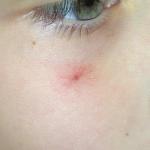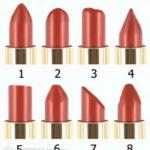Cotton is burning. Wool fiber
10.03.2017
The composition determines all the properties of the material, and therefore of future clothing. Typically, manufacturers indicate the type and percentage of fibers. But it won’t hurt to know how you can determine the structure of the fabric yourself. After all, it is not always possible to familiarize yourself with the markings, and cases of distortion of information about the material are not excluded.
What determines the composition of a fabric?
Proper determination of fabric composition plays an important role in choosing fabric for sewing. It depends on:
- purpose of the fabric
- cost of material,
- sewing technology,
- choice of style,
- features of care of the finished product.
For clothes intended for summer and winter seasons, daily wear and holiday occasions are selected different kinds fabrics Items in contact with skin must contain a large number of natural fibers, provide a pleasant feeling, comfortable conditions for ventilation. Outerwear protects against cold - in this case, the thermal insulation and waterproof properties of the material are important. For everyday products, practicality and wear resistance, etc. are important. Knowing the composition of textiles, you can accurately determine its purpose and choose the optimal style.
All fabrics have certain requirements for sewing technology. The specifics of the cut, the choice of needles, threads, and seams depend on the content of different types of fibers. Accurate information allows you to ensure ease of use and high quality results.
Tactile determination of fabric composition
Information about the composition is placed on the labels. Manufacturers, indicating this data, arrange the types of fibers based on their content in the material, from higher to lower values. For example, this one is 60% wool, 30% cotton and 10% polyester. However, if it is impossible to get acquainted with such information, you can try to determine the type of fabric using tactile sensations:
- silk has tenderness, softness, the hand glides over the surface;
- cotton gives a feeling of warmth, is pleasant to the touch, soft, wrinkles easily;
- linen is much stiffer and creates a feeling of coolness;
- the wool gives a slight tingling sensation, warmth, and practically does not wrinkle;
- viscose has a pleasant shine, is soft, delicate, and wrinkles to the touch;
- Nylon, polyester, nylon have a slippery surface, and the material crumbles when cut.
Determination of composition by combustion
The range of fabrics is huge. It is difficult to accurately determine the composition by tactile sensations, and especially to identify the presence of synthetic fibers in mixed versions. The nature of the tissue combustion and the odor emanating from it will help in studying the composition. To determine the type of fiber, you need to pull the thread out of the fabric and set it on fire:
- cotton and linen fibers burn intensely, the flame has a yellowish color, can sparkle, after combustion there remains ash without lumps, which smells like burnt paper;
- the burning of wool and silk is less intense, a ball of dark color remains, when touched it crumbles, the smell of burnt hair is felt;
- the burning of viscose is similar to that observed when burning cotton, but this material burns out much faster;
- When acetate and triacetate fibers burn, a vinegar smell appears, flames yellow color, the resulting lump can be easily crushed with your fingers;
- the lavsan (or polyester) thread burns slowly, soot appears, and a hard ball remains;
- when nylon fibers are set on fire, the smell of sealing wax is felt, white smoke is visible, and a hard dark lump remains;
- polyvinyl chloride thread does not burn, it chars, emitting a chlorine odor;
- Nitron fiber burns in flashes, black soot is released, and a lump remains that can be crushed with your fingers.
Materials can be made from mixed fibers. When burning such filaments, the type of flame and odors depend on the predominant component. It should be taken into account that after burning natural fibers, only ash remains. If there are hard lumps in it, then the fabric contains synthetic impurities.
In order to get a more detailed understanding of the behavior of fabrics of different compositions during combustion, we created the section #burn on our YouTube channel. Join us and enjoy watching!)
Although we ourselves sometimes do not mind being deceived. In pursuit of a low price, instead of quality materials, we often give preference to cheaper fabrics. At best, such savings result in discomfort when wearing, at worst - allergies and other health problems.
What fabrics should you buy from when building your wardrobe? How to avoid falling for the bait of unscrupulous sellers? Is it possible to determine the composition of a thing without laboratory tests? We talked about this and much more with a candidate of technical sciences specializing in “Technology of textile materials, clothing and knitwear» Galina Skripko on AiF.ru.
It's not cold in winter, not hot in summer
Natalya Kozhina, AiF.ru: Galina Alekseevna, what is “healthy clothing”, which in fact should make up our wardrobe?
Galina Skripko: Clothing is considered healthy if the textile material is made from natural raw materials (cotton, wool, flax, natural silk, etc.) or from material with a high content of it.
It is always comfortable to wear such clothes: it is not cold in winter, and not hot in summer, because the material containing natural fibers, has unique property- keep warm for a long time, slowly cooling, and vice versa, keep cool, slowly warming up. Such material does not have a negative effect on the human biofield, since natural fibers are not capable of accumulating static tension. Due to the high breathability and ability of the material to absorb moisture, the clothing becomes hygienic.
N.K. “AiF.ru”: Is it possible to determine good and high-quality fabric only by its price?
G.S.: No. The initial price for the product is determined by the manufacturer, the final price is determined by the distributor. Both focus on consumer demand when determining prices. In this case, less fashion clothes, although of high quality, can be offered to the buyer at a lower price than a branded one made from lower quality raw materials.
Sometimes, in order to increase sales, manufacturers and distributors of textile products directly deceive the buyer by indicating deliberately false information about the fiber composition of the material on the product label or price tag.
N.K. “AiF.ru”: If price is not an indicator, then what factors can help determine the quality of the fabric?
G.S.: Subjectively, the quality of the material can be determined by appearance and to the touch. Some natural fibers have a characteristic odor. For example, wool has its own smell, it is difficult to describe it, but when we smell it, we remember it. Why does wool smell? Because she has fatliquoring agents, these products have such a specific smell. Cotton smells fresh.
The naturalness of modified fabrics can be determined by external signs difficult even for a professional. Thus, fabric or knitwear made from mercerized cotton (Mercerized cotton is cotton that undergoes alkali treatment. The fiber becomes thinner, shrinks less and is more even) in appearance differs little from material made from polyester cotton-like fiber.
In everyday conditions, to determine the type of clothing fibers, we can recommend a method based on the characteristics of combustion and the characteristic odor of the combustion residues of the fibers. For example, cotton yarn burns quickly, leaving a burnt paper smell; the burnt residue is easily crushed between your fingers. Yarn made from polyester fibers is characterized by rapid attenuation, the burnt residue has the appearance of a solid black ball, and there is no smell. The presence of fur or natural silk in yarn is determined by the characteristic smell - burnt horn. If the combustion residue does not crumble when rubbed between your fingers, then the yarn contains synthetics.
N.K. “AiF.ru”: Often in a store you can see things made of 100 percent cotton (i.e., identical in composition), but at the same time they will feel completely different to the touch, why? In this case, what fabric should you choose?
G.S.: Everything is correct. Same in fibrous composition textile materials can have different textures. Texture is determined by the density of the fabric and its thickness. The density of the fabric depends on the density and type of weave of the yarn, and the thickness depends on the thickness of the yarn. If we talk about cotton fabrics, their range is very wide: calico, chintz, satin, crepe, cashmere, flannel, flannel, cambric, etc. The thinnest and most expensive fabric is cambric. It is made from fine, tightly spun cotton yarn, which is obtained from high-quality long-staple cotton. When assessing the quality of the fabric or material of the product, you should carefully examine its surface for defects: thickening of the yarn in limited areas, flakiness (the presence of small lumps of tangled fibers on the surface of the fabric), knots, violations in limited areas of the density of the fabric due to vacuum or compaction between the interweaving of threads , the presence of distortions in the direction of the threads, uneven coloring, displacement of the pattern, etc.
Fabric and knitwear, the yarn of which is made from high-grade fiber, has a smooth surface. The denser the material, the less it deforms during use of the product. However, dense material does not mean thick.
W, CO, CVI - designations that are important to know
N.K. "AiF.ru": What fabric should be used when creating a children's wardrobe?
G.S.: The production of children's clothing requires its compliance with sanitary and hygienic rules and regulations (SanPin), according to which children's underwear up to size 32 and hosiery up to size 16 should not contain synthetic fibers. It is allowed to replace part of the cotton with artificial fiber - viscose:
- up to 10%, for toddler underwear (up to size 28) and hosiery up to size 16;
- up to 30%, for children's underwear up to size 32.
N.K. “AiF.ru”: What fabric composition is ideal for underwear and swimwear?
G.S.: Underwear made from 100% cotton jersey is considered ideal. To increase the elasticity of knitwear, it is permissible to add elastic thread (elastane, spandex) to the yarn, the content of which should not exceed 2-1%. Underwear made from such knitwear is not only hygienic, but also more comfortable, as it fits tightly to the body.
N.K. “AiF.ru”: Galina Alekseevna, please tell us about the symbols that are often used on labels, what do they mean?
G.S.: The designation of raw materials must contain the full name of the types of fibers or their abbreviated designation. The abbreviated designation is mainly used by foreign manufacturers. For example, cotton (cotton) - CO, ALG; flax (flax) - Li; wool (wool) - W or WP, WL, WA (alpaca, llama, angora wool): silk (silk) - SE. For artificial chemical fibers the following designations are used: viscose (viskose) - Vis, VI; high-modulus fiber (Siblon, Modal) - CVI, MD; acetate - AC. Synthetic fibers are designated: polyester (polyester) - PE, PE, PES, PL; polyacrylonitrile (acrylic) - PAN, PAC, RS; polyamide (polyamide) - PA, RA; polyurethane (polyurethane, elastane) - PU, PU, EA.
In duplicated canvases, the composition of the raw material is indicated separately for each layer.
When secondary raw materials are included in the material, the words “recycled raw materials” and its type must be indicated.
Hi all. I very often heard questions of the following kind: is this calico made of natural cotton Or is this cotton fabric natural? Of course, these questions do not arise out of nowhere, especially in our difficult times, where on every corner they offer a fake at the price of a natural product. After such questions, I felt the desire to write an article, thanks to which attackers will have much less chance of deceiving you.
1.
2.
3.
4.
A little about cotton and cotton fabrics.
Cotton is an environmentally friendly product.
Cotton, and, as a result, natural cotton fabric themselves are a natural and environmentally friendly product. Such famous types of fabrics as calico are made from cotton, and at the same time, they may differ in price. It's all about the varying complexity of production. The cost can vary from 1000 rubles to 10,000 thousand or more. Agree, I would not want to buy satin for 5-6 thousand rubles, which is made from synthetics and is not worth even a fifth of this money. That is why we read on and gain useful knowledge. By the way, I would like to point out that cotton and cotton fabric are one and the same.
9 ways to identify a natural cotton product from a synthetic counterfeit.
Now let's talk directly about how to distinguish synthetics from high-quality cotton. There are various methods, some are quite easy to use, we will analyze them first, some are more difficult.Regardless of the method, I advise you to first look at the product tag. According to all rules and laws, the manufacturer is obliged to write the truth on the product label. However, if you have any doubts about the authenticity of the product, we proceed to check.

Easy ways to spot a fake “without leaving the cash register”:
- 1st method: definition product weight . Any cotton product is quite heavy. Everything here is hidden in cotton fibers; they are much heavier than synthetic ones. If you take a set of bed linen, the same density, then underwear made from natural cotton will be much heavier than synthetics. Pay close attention to this, the usual weight of a set of cotton bed linen ranges from 1.9 – 2.5 kg, while a set of synthetics weighs 0.5 – 1 kg.
- 2nd method: electrification. Electrification is the property of a material to accumulate a static charge. Simply put, if you rub synthetic fabric, it will crackle and glow in the dark. Cotton fabric will never behave like this; from the point of view of electrification, it is neutral.
- 3rd method: definition by touch. Cotton fabrics are very soft to the touch and quickly take on body temperature, i.e. become warm. In turn, synthetic fabrics always remain cold.
- 4th method: shine. Cotton fabrics are naturally non-shiny. This property is inherent in synthetic fabrics. However, there is an exception in the form of satin; for this fabric this advice will not be relevant. Due to its weaving and twisting of the threads, there is still a slight shine on it, however, other types of fabrics are calico, poplin, etc. do not shine and you can safely use this method.
- 5th method: creasing. Crumple a piece of fabric; if it turns out to be cotton, it will crumple quite badly; synthetic fabric practically does not wrinkle and regains its shape very quickly.
- 6th method: price. The cost indicator can give an excellent hint when choosing a quality cotton product. If you see a set of cotton satin bed linen in a store for 600 - 800 rubles, you should know that it is a fake. High-quality satin bed linen cannot cost that much. The right decision will compare the price in two or three different stores and formulate for yourself the average price for a certain type of fabric. After this, take into account the average cost, and do not chase for “super”cheap price. Remember, the miser pays twice!
The beauty of the methods listed above is that they allow you to identify a fake at the purchase stage. Remember them and don't forget to apply them.Now let's talk about more complex methods. They themselves are of course not complicated, but at the purchasing stage you most likely won’t be able to use them.
- 7th method: combustion. Cotton fabrics, when burned, emit the smell of burnt paper, and after burning they leave ash. Synthetic fabrics in turn, they do not burn, but smolder and leave their own specific smell.
- 8th method: pellets. Cotton fabric never forms unpleasant pills during use, which cannot be said about synthetics. Look at your old cotton clothes and you will see this. By the way, you can try to apply this method at the purchasing stage; even new synthetic fabric forms a few pills if you stroke it a little and look closely.
- 9th method: drying after washing. Natural bed linen cotton fabric After washing it dries much longer than any synthetic material.
Two latest methods are 100% in determining the naturalness of the product, but, most likely, not a single seller will allow you to use them at the purchase stage. And as a rule, you can use them after purchase.
Let's summarize.
This is where I will end my article. Be more careful when choosing bedding or cotton fabrics. Use all the voiced methods, choose the best. If you have a lot of experience in identifying natural cotton fabrics, I and all readers would love to hear from you. Leave your tips in the comments. Don't forget to repost.Sincerely, Victoria Morozova.
Today we have laboratory work. Today we are setting fire to yarn. Not for the sake of self-indulgence, but for the sake of determining its composition. Experts call this process an organoleptic method for recognizing fiber by burning.
For what? Many years ago, you bought yarn, knitted something from it, and put the rest in long-term storage, forgetting to sign it. Or someone gave you yarn without labels, and you don’t know its composition. Or there may be some other situation, and the composition is also unknown. Is it necessary to at least roughly know what kind of animal is in your hands?
Is it necessary to know the composition of the yarn? Isn't it enough to visually and tactilely examine the thread and knit the product based on the thickness and color of the thread? No. The color and thickness are very insufficient.
Imagine, without knowing the composition of the yarn, you knitted a product, washed it and... The product stretched greatly in breadth or shrinked greatly. And if your summer T-shirt After washing it fluffed up a lot and resembles a shawl. Or your jumper has been welded so that its fabric has lost its pattern and resembles felt boots. These are not all the troubles that can happen due to a lack of understanding, what kind of yarn lies in front of you?
I suggest you at least roughly determine what you have to work with. Let's set fire to pieces of yarn. I remember we did this at school during home economics lessons, but there we burned fabric. The essence does not change today, since fabric and yarn are made in production from the same materials. So.
We take about 10 cm of yarn and set one end on fire. We look at how quickly the thread burns, what the color of the flame is and the nature of the combustion, pay attention to the smoke, if there is any. As soon as half of the thread has burned, we blow it out sharply and look at the result. As soon as everything has cooled down, we try to rub the combustion product with our fingers, that is, what remains after combustion.
Ball 1. The thread is badly eaten by moths. You don't have to burn it. The thread is natural, wool, quite edible and even very tasty. If the moth that found this ball died of gluttony without having time to leave offspring, you will not find it. Set fire to the thread. Wool doesn't melt. It burns slowly, the flame is weak and flickering, and the smoke smells like burnt feathers or hair. During combustion, black or dark brown ash appears in grains. The cooled grains crumble into powder. Chemists claim that wool is resistant to mineral acids, and is destroyed in hot sulfuric acid and weak alkali solutions.
Tangle 2. Silk. This is an animal fiber. It burns like wool, it smells the same, and when burned, its ash also forms in the form of a black ball, which also crumbles into powder. We are talking about natural silk. Rayon is a synthetic.
Tangle 3. Viscose. This fiber has a silky shine. Burns quickly and brightly, does not melt, smells of burnt wood or paper, leaves a light ash. Viscose dissolves in hot dilute and cold concentrated acids. Concentrated alkali solutions cause it to swell.
Tangle 4. Cotton. This vegetable fiber. It ignites easily, burns quickly with a bright yellow flame and has a burnt paper smell. When burned, it leaves a white-gray ash. Cotton is not very resistant to chemicals and minerals, mineral acids, but is resistant to alkalis.
Tangle 5. Linen. This is also a plant fiber, and when burned it behaves in the same way as cotton, only it extinguishes faster and smolders poorly.
Tangle 6. Synthetics. There are a lot of synthetic fibers in production, and they all behave differently. Acrylic, nitron, acetate, nylon, nylon, polyester, spandex and a bunch of others with unearthly names - these are all synthetics. But they have a common property - they do not burn and do not leave ashes. They melt, leaving a dense ball. This is why firefighters and the Ministry of Emergency Situations do not recommend synthetic clothing. If the flame from natural clothing can be knocked down or extinguished, then the remnants of melting synthetic clothing stick to the body and leave burns. In addition, the smoke that is produced during combustion, that is, during melting, is often very poisonous. This is why in case of fires in large entertainment venues, where everything is decorated with plastic, people die not from fire, but from poisoning and suffocation. But not all synthetics stink so bad. For example, acrylic or melting reminds the smell of fish, acetate smells like vinegar and paper, nylon smells like celery. By the way, the color of the melted synthetic balls can also be different, creamy, bluish, and black. When frozen, these balls do not crumble into ashes, which distinguishes synthetic fibers from natural ones.
To summarize, we can say that fibers of plant origin (cotton, flax and everything that during their life represents grass and trees) when burned smell like burnt paper or wood, fibers of animal origin (wool, silk and everything that walks and eats during life) and makes sounds) when burning they smell like burnt feathers and hair, and fibers of synthetic origin, like all chemicals, can smell like anything and even stink like anything. The ash of fibers of plant and animal origin crumbles, and in most cases artificial ash is sintered into hard balls. I repeat: in most cases. This means that scientists do not stop there and the products of their creativity may soon give natural ones a head start, if they have not already.
Attention! These descriptions only apply to 100% yarn compositions. If the thread is a mixture of different fibers, it may be difficult to determine them, and even more so in their percentage composition. But here too you can fight.
Try to take the thread apart into pieces. If the thread is untwisted, it is often seen that it is assembled from different fibers. Using tweezers, sort these fibers into different piles, estimate the percentage and burn each pile separately, forming a ball from each pile or even twisting the threads.
Stop! They forgot about the most important thing! Safety precautions! Before you start experimenting, protect your hair with a headscarf and prepare the room, remove extraneous odors, and eliminate drafts. After burning one thread, ventilate the room, burn the second thread and ventilate the room again. Be sure to place something non-flammable under the material you are burning. Let it be a plate, a baking sheet from the oven or a simple sheet of foil from a chocolate bar. It is not recommended to use matches; they are wooden, and their smell will overwhelm the smell of burnt thread and interfere with the experiment. A candle or a simple lighter will help you. Be sure to have water ready so that you can put out a fire that has gotten out of control in time. Remember that some fibers do not ignite immediately, but once ignited, they become excited and do not want to go out.
You can, of course, test the fibers chemically. For example, in nitric acid (HNO 3) cotton will dissolve and wool will turn yellow. And if you immerse cotton in a 10% solution of caustic soda (NaOH), it will swell, but wool will simply dissolve.
But you are unlikely to carry out such experiments at home, it is unsafe, and the necessary solutions may simply not be available at home.
How to distinguish natural fabric from synthetics? This problem especially often arises when purchasing bed linen. People out of habit believe that if it is calico, it must be pure cotton. But, whether it is calico or poplin, this definition does not refer to the quality of the thread from which the fabric is woven, it is the name of the weaving technology. And, as you understand, you can weave it from any thread, even from wire.
Therefore, in order not to feel deceived, you need to know how to check what fiber a product is made of.
The first test is tactile sensation. Even if the fabric is natural, you don't have to like it. And this factor plays an important role when choosing. For example, for many, pure flax fiber seems coarse; they also often talk about thick and high-quality calico.
Satin seems thin to many, although it is completely opaque, like calico, comfortable, and a pleasure to sleep on. Therefore, relying only on tactile sensations, you can just buy soft, pleasant, velvety, but synthetic underwear.
There is a simple home way to check the naturalness of the thread - you need to set it on fire.
If you buy clothes, then, as a rule, there is a spare piece of fabric, you can conduct an experiment on it.
WITH bed linen more complicated, it does not come with a fabric sample, so you will have to be smart about how to check whether the fabric is actually natural, as stated by the manufacturer.
So, if you have a piece of fabric or at least a thread, let's start doing research. To do this, we need a safe place, matches, and the ability to ventilate the room.
How to distinguish natural fabric from synthetic
- Cotton fiber burns with a light flame, burns very quickly and does not leave a strong odor, to some it slightly resembles the smell of burnt paper. There is very little ash left, and it is completely weightless.
- Flax also burns quickly, leaving very little bright gray ash, but leaves no odor.
- Purely wool thread burns very slowly and reluctantly, eventually shrinking into a ball, filling the space unpleasant smell resembling burnt hair or feathers.
- Artificial wool burns very quickly and beautifully - the flame is blue, and the smell will be as if paper was set on fire.
- Viscose obtained artificially from wood, i.e. cellulose is considered a natural fabric. Viscose burns very quickly, but smolders for a long time, actively smoking and emitting the smell of burnt cotton wool. The remaining gray ash crumbles well.
How to distinguish natural silk from artificial silk
Natural silk does not want to burn at all, no matter how hard you try. The thread will shrink into a black knot, and the flame will immediately go out. The smell is vaguely reminiscent of burnt keratinizations (nails, claws, horns), if you have ever heard such a smell.
It is very easy to distinguish artificial silk from natural silk. It burns well and quickly, without crackling or odor.
When buying a silk item, you will not start a fire in the store, so just squeeze the fabric in your hand, unclench your fist after a while and see if the fabric is wrinkled. Artificial silk will have noticeable creases, natural silk It will wrinkle quite a bit.
A characteristic feature of all burnt natural samples is the ability to easily crumble combustion residues. Artificial thread does not provide such an opportunity, in addition, when artificial material burns, it emits an odor mixed with sourness.
Acetate silk can melt in acetone, which cannot be said about natural silk.
IN Lately a lot of mixed fabrics have appeared containing natural thread in combination with artificial. The manufacturer is required to indicate the percentage of all types of threads - these can be acrylic, acetate fiber, lavsan and other artificial additives. If you set fire to such fabric, the flame will be similar to the thread that contains the most of it. The smell will also determine the composition, but the remains of combustion cannot be easily crushed.
Mixed fabrics used in the production of bed linen are, as a rule, very pleasant to the touch, have a durable color, practically do not wrinkle and last a long time if used correctly.
Be able to distinguish natural fabric from artificial It is also necessary to properly care for the product.






